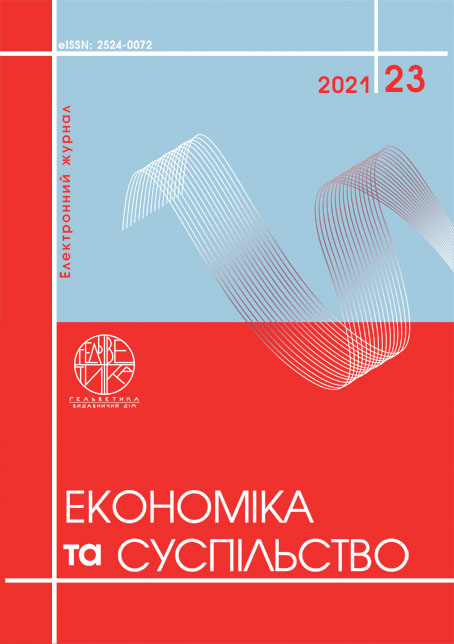ECONOMIC FEASIBILITY OF DEVELOPMENT IN UKRAINE MODERATE LIBERALIZED MARKET OF THERMAL ENERGY
Abstract
Communities that own utilities in Ukraine suffer from poor quality services and high tariffs due to inefficient use. This article is devoted to the analysis of the dynamics of tariffs of enterprises that generate, transport and supply thermal energy, providing heating services for residential buildings and hot water supply in Ukraine, as well as the study of the functioning of the competitive market model of thermal energy producers in the European Union and borrowing their positive experience in Ukraine in order to protect the economic interests of consumers, preserve the heat supply system, prevent the division of the heating network into groups of objects that are heated by separate small boiler houses, by ensuring competitive tariffs in comparison with individual and autonomous heating systems. Different countries with a competitive heat market have different approaches to tariff setting, protection of heating utilities or investment protection. It was found that a moderately liberalized heat energy market may be acceptable for Ukrainian conditions, providing for moderate protection of the main producers – heat supply utilities and creating market conditions for independent producers. Considering that the overwhelming majority of apartment buildings in Ukraine are connected to the district heating system, and the system itself is monopolized by the state, a decrease in heat tariffs is possible if independent heat energy producers are connected to the centralized network of capacities, operating on biofuel or other alternative types of energy that can offer higher quality services at a lower cost compared to that offered by the old utility heat supply companies, which are mainly dependent on gas or coal. This article shows that the model of tariff formation in Ukraine, proposed on the basis of studying approaches to setting tariffs in the European Union, gives a moderate decrease in the weighted average tariff for heat energy for the end user at the initial stage of market development, ensures fair competition between the operator – a utility company and independent manufacturers, and also stimulates the operator to improve the efficiency of their own production.
References
Черенько Л. За перше півріччя 2020 року рівень бідності в Україні зріс із 41% до 51%. Сайт Інституту демографії та соціальних досліджень ім. Птухи НАН України. URL: https://www.idss.org.ua/index (дата звернення: 16.01.2021).
Зростання тарифів на опалення – чому дорожчає тепло та газ. Слово і Діло. URL: https://www.slovoidilo.ua/2021/01/06/stattja/suspilstvo/komunalni-platezhi-chomu-opalennya-dorozhchaye-xocha-zelenskyj-obicyav-znyzyty-taryfy (дата звернення: 16.01.2021).
Прудка Н. Все про ціни на газ, тепло та електроенергію у 2021-му. Главком. URL: https://glavcom.ua/economics/finances/z-novimi-tarifami-vse-pro-cini-na-gaz-teplo-ta-elektroenergiyu-u-2021-mu-727836.html (дата звернення: 16.01.2021).
Майстришин В., Домбровський О., Гелетуха Г. Яка модель ринку теплової енергії потрібна Україні. URL: https://zn.ua/ukr/energy_market/yaka-model-rinku-teplovoyi-energiyi-potribna-ukrayini-_.html (дата звернення: 16.01.2021).
Домбровський О.Г., Савчук С.Д., Гелетуха Г.Г., Корсакайте Д., Крамар В.Г. Централізоване теплопостачання. URL: https://power-ua.com/pdf/konkurenciya_v_teplosnabjenii.pdf (дата звернення: 16.01.2021).
Ющенко Н.Л. Методи оцінки ризиків державно-приватного партнерства в теплоенергетиці та заходи для ліквідації наслідків їх виникнення. Таврійський науковий вісник. Серія: Економіка. 2020. Вип. 4. С. 194-204. doi: 10.32851/2708-0366/2020.4.24
Harri-Pekka Korhonen. Regulated third-party access in heat markets: how to organize access conditions. Oxera Agenda June 2014. URL: http://www.oxera.com/getmedia/195b43b0-6bd3-4fc4-8b13-df95f80acf2e/Regulated-third-party.pdf.aspx?ext=.pdf (дата звернення: 16.01.2021).
Cherenko, L. (2021) In the first half of 2020, the poverty rate in Ukraine increased from 41% to 51% [Za pershe pivrichchia 2020 roku riven bidnosti v Ukraini zris iz 41% do 51%]. Website of the Institute of Demography and Social Research named Ptukhi of the National Academy of Sciences of Ukraine. Available at: https://www.idss.org.ua/index (accessed 16 January 2021).
Slovo i Dilo (2021) Rising heating tariffs – why heat and gas are becoming more expensive [Zrostannya taryfiv na opalennya – chomu dorozhchaye teplo ta gaz]. Available at: https://www.slovoidilo.ua/2021/01/06/stattja/suspilstvo/ komunalni-platezhi-chomu-opalennya-dorozhchaye-xocha-zelenskyj-obicyav-znyzyty-taryfy (accessed 16 January 2021).
Prudka, N. (2021) All about gas, heat and electricity prices in 2021 [Vse pro ciny` na gaz, teplo ta elektroenergiyu u 2021-mu]. Glavkom. Available at: https://glavcom.ua/economics/finances/z-novimi-tarifami-vse-pro-cini-na-gaz-teplo-ta-elektroenergiyu-u-2021-mu-727836.html (accessed 16 January 2021).
Maistryshyn, V., Dombrovsky, O. & Geletukha, G. (2016) What model of thermal energy market does Ukraine need [Yaka model` ry`nku teplovoyi energiyi potribna Ukrayini]. Available at: https://zn.ua/ukr/energy_market/yaka-model-rinku-teplovoyi-energiyi-potribna-ukrayini-_.html (accessed 16 January 2021).
Dombrovsky, O.G., Savchuk, S.D., Geletukha, G.G., Korsakaite, D. & Kramar, V.G. (2018) District heating [Tsentralizovane teplopostachannia]. Available at: https://power-ua.com/pdf/konkurenciya_v_teplosnabjenii.pdf (accessed 16 January 2021).
Yushchenko, N.L. (2020) Methods of risk assessment of public-private partnership in heat energy and measures to eliminate the consequences of their occurrence [Metody otsinky ryzykiv derzhavno-pryvatnoho partnerstva v teploenerhetytsi ta zakhody dlia likvidatsii naslidkiv yikh vynyknennia]. Taurian Scientific Bulletin. Series: Economics, 4, 194-204. doi: 10.32851/2708-0366/2020.4.24 [in Ukrainian].
Harri-Pekka Korhonen (2014) Regulated third-party access in heat markets: how to organize access conditions. Available at: http://www.oxera.com/getmedia/195b43b0-6bd3-4fc4-8b13-df95f80acf2e/Regulated-third-party.pdf.aspx?ext=.pdf (accessed 16 January 2021).


